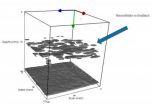(Press-News.org) ALEPPO, SYRIA (20 April 2011): Researchers meeting at a scientific conference in Aleppo this week reported that aggressive new strains of wheat rust diseases – called stem rust and stripe rust – have decimated up to 40% of farmers' wheat fields in recent harvests. Areas affected are North Africa, the Middle East, Central Asia and the Caucuses, including Syria, Egypt, Yemen, Turkey, Iran, Uzbekistan, Morocco, Ethiopia, and Kenya.
“These epidemics increase the price of food and pose a real threat to rural livelihoods and regional food security,” said Mahmoud Solh, Director General of the International Center for Agricultural Research in the Dry Areas (ICARDA).
In most of the countries in Africa, the Middle East, and Central Asia and the Caucuses, where wheat can contribute more than 40% of people's food calories and 20% of the protein, the epidemics cause economic hardship for farmers and their families.
More than 100 scientists and policymakers from 31 countries are meeting at the International Wheat Stripe Rust Symposium 18-20 April at ICARDA, in Aleppo, Syria, to discuss strategies for wheat rust surveillance and monitoring, development of rust-resistant wheat varieties, and crop diversity strategies to slow the progress of rust across large areas of Africa, the Middle East and Asia.
“Some of the countries affected by rust epidemics have invested very little in agricultural research and development,” said Hans Braun, director of the Global Wheat Program at the International Maize and Wheat Improvement Center (CIMMYT) in Mexico. At the meeting, he challenged policymakers to recognize the link between scientific research and food security and to invest more heavily in agricultural research.
Climate change, in terms of rising temperatures, and the timing and increasing variability of rainfall, is contributing to the spread and severity of rust diseases. Emerging races of rust are showing adaptations to extreme temperatures not seen before. Scientists around the globe are working on monitoring and surveillance of stem rust and stripe rust to insure rapid detection and reporting so farmers, policymakers, and agricultural research centers can respond more quickly to initial outbreaks.
“To combat the problem of wheat rusts, farmers in these regions need to adopt new varieties of wheat that have durable resistance to both stem and stripe rust,” said Ronnie Coffman, vice chair of the Borlaug Global Rust Initiative.
New rust resistant varieties are in the pipeline at international and national agricultural research centers. Breeders are selecting for other important characteristics including improved yield performance, drought tolerance, and regional suitability.
Country preparedness for outbreaks of wheat rust involves such issues as the availability of resistant varieties that are known to and accepted by farmers, the availability of sufficient quality seeds of new varieties for farmers to use, and the availability, accessibility and affordability of effective fungicides and capacity of farmers to use them.
In most cases, the bottleneck to getting resistant varieties into the field in time to protect local harvests is local capacity and the ability of national programs to rapidly multiply seeds and deliver them to market. Improving country capacity requires long-term planning, funding, and getting farmers involved earlier in the variety selection process.
“There is need for enhancing in-country capacity of the breeding, seed and extension systems to continuously ensure that new, highly productive and genetically diverse resistant varieties are available and accepted by farmers to meet the challenges of changing rust virulence,” said Wafa El Khoury, coordinator of the Wheat Rust Disease Global Program at the Food and Agricultural Organization (FAO). “Coordination and timely information sharing among all the stakeholders—from surveillance and plant protection officers, to wheat breeders, seed system and extension agents, and farmers—is key.”
###
For more information, see http://icarda.org/wheatrust/ and www.globalrust.org
The International Wheat Stripe Rust Symposium at ICARDA is fully organized by ICARDA – the International Center for Agricultural Research in the Dry Areas — in collaboration with the Borlaug Global Rust Initiative (BGRI), the International Maize and Wheat Improvement Center (CIMMYT), the Food and Agricultural Organization (FAO) of the UN, the International Development Research Center (IDRC, Canada), the Association of Agricultural Research Institutions in the Near East & North Africa (AARINENA), and the International Fund for Agricultural Development (IFAD).
Established in 1977, ICARDA is one of 15 centers supported by the Consultative Group on International Agricultural Research (CGIAR). ICARDA’s mission is to contribute to the improvement of livelihoods of the resource-poor in dry areas by enhancing food security and alleviating poverty through research and partnerships to achieve sustainable increases in agricultural productivity and income, while ensuring the efficient and more equitable use and conservation of natural resources. The Center is headquartered in Aleppo, Syria, with offices in sixteen other countries. (www.icarda.org)
END
Local extinction rates of American pikas have increased nearly five-fold in the last 10 years, and the rate at which the climate-sensitive species is moving up mountain slopes has increased 11-fold, since the 20th century, according to a study soon to be published in Global Change Biology. The research strongly suggests that the American pika's distribution throughout the Great Basin is changing at an increasingly rapid rate. The pika (Ochotona princeps), a small, hamster-looking animal sensitive to climate, occurs commonly in rocky talus slopes and lava flows throughout ...
Data from NASA's Cassini spacecraft have revealed that Enceladus, one of Saturn's diminutive moons, is linked to Saturn by powerful electrical currents - beams of electrons that flow back and forth between the planet and moon. The finding is part of a paper published in Nature today.
CAPS, one of the instruments on board Cassini which made the electron beam discovery, includes a electron sensor called CAPS-ELS – led by UCL (University College London).
Since Cassini's arrival at Saturn in 2004 it has passed 500km-wide Enceladus 14 times, gradually discovering more of ...
The nationwide economic recession has cost tens of thousands their jobs, forced millions into foreclosure and resulted in countless bankruptcy filings. Despite their best efforts, many people are falling behind on mortgage payments due to financial circumstances beyond their control. In an effort to avoid foreclosure, more and more people are seeking loan modifications as a way to lower payments temporarily (or permanently), making them more affordable and making keeping the home a real possibility.
Unfortunately, at a time when foreclosures are at a record high, unscrupulous ...
Researchers of Apoptosis and Cancer Group of the Bellvitge Biomedical Research Institute (IDIBELL) have found that a small molecule, Nutlin-3a, an antagonist of MDM2 protein, stimulates the signalling pathway of another protein, p53. By this way, it induces cell death and senescence (loss of proliferative capacity) in brain cancer, a fact that slows its growth. These results open the door for MDM2 agonists as new treatments for glioblastomas. The study has been published at the journal PLoS ONE.
Glioblastoma multiforme is the most common brain tumour in adults and the ...
In a multicellular organism, different cells fulfill a range of diversified functions. Often such specialization depends on the delivery of molecular goods to distinct places within a cell. It ensures that particular functions only occur at defined cellular sites. This establishment of intracellular asymmetry in the otherwise fluid environment of the cell cytoplasm requires active transport processes. Messenger RNAs (mRNA) represent an especially important type of freight. They are copies of genetic information stored in the nucleus. In the cytoplasm the information encoded ...
Expectant mothers are familiar with the procedure: the physician examines them with an ultrasound apparatus that displays lifelike images of the fetus on the monitor. The application of this technology has been customary in medicine for years; in materials testing though, it has been used only in relatively rudimentary form to date. Researchers at the Fraunhofer Institute for Non-Destructive Testing IZFP in Saarbrücken have adapted the conventional sonar procedure – a simple ultrasound method – and have succeeded in generating three-dimensional images with the aid of innovative ...
Prosecutors trust that the information they receive from crime labs is correct and accurate. The results from tests run at the lab are used to help build cases against those accused of crimes. When this information is inaccurate it can lead to questions for both past and future cases, and in some instances, lead to innocent people being convicted of crimes they did not commit. The Nassau County crime lab recently became the only police lab in the nation to completely close its doors due to its inability to follow procedures.
The lab's troubles started in December 2010. ...
It turns out to be difficult to find out exactly how much a child who cannot yet speak suffers after a surgical operation. Researchers at the University Hospital of La Paz, in Madrid, have validated the 'Llanto' scale, the first, and only, tool in Spanish which measures infant pain rapidly and simply.
"The lack of appropriate tools prevents health professionals from knowing if a pre-verbal child who cannot tell us how much a surgical wound hurts, is being treated correctly", explains Francisco Reinoso, lead author of the study and head of the section of Paediatric Anaesthesia ...
BATON ROUGE – On the one year anniversary of the Deepwater Horizon oil spill that took the lives of 11 men and devastated the livelihoods of many residents of coastal Louisiana, it's difficult to put the complicated relationship between people and oil into perspective. While the environmental impacts have thus far not been as pervasive as originally feared, most scientists are in agreement that it is still simply too early to tell. However, dependence upon oil has not lessened over the past year, laying the groundwork for some very significant debates between environmentalists ...
The Northeast has seen three tour bus accidents in less than a month. On March 21, a New Jersey-based PRT tour bus rolled over in New Hampshire, seriously injuring five people.
The bus was travelling to Boston from Quebec, carrying 25 Koreans. The driver apparently lost control on a snowy highway.
On March 15, a bus headed from Chinatown to Philadelphia crashed on the New Jersey Turnpike in East Brunswick, killing two, the driver and a passenger.
The worst accident of the three happened on March 12, with 15 passengers killed when a Worldwide Tours Bus headed to ...


